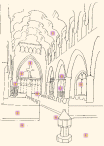
 |
  |
PROCESSIONS AND SPACES
The medieval church set different activities for different areas - mass at the eastern end, and baptism to the west are but some of more obvious examples. The relegating to different classes and functions their appropriate space did not necessarily mean segregation of groups. The frequent use of processions, large and small, in medieval Christian worship, brought different groups in, through, and around each other’s spaces. The clergy processed regularly within and around the church on Sunday and feast days. The reading of the Gospel invariably involved some sort of movement across spaces. The sacrament was brought out into the streets and movement occurred between churches. Margery Kempe speaks of honoring the Eucharist, especially when she “saw the precious sacrament borne about the town with lights and reverence, the people kneeling on their knees” (Ch. 72). On the feast of Corpus Christi, the solemn procession with many candles and great solemnity went through the town (Ch. 45). She mentions the rituals of Holy Thursday when she went in procession with other people (Ch. 73). Palm Sunday, when the clergy process with the sacrament, ritually recreating the entrance of Christ into Jerusalem, is mentioned in Chapter 78. The priest smites the closed church door with the cross, and the doors are open. He enters with the sacrament and all the people follow. In Jerusalem (Ch. 28), the Franciscans lifted up a cross and led Margery and other pilgrims through the Church of the Holy Sepulchre in a procession. |